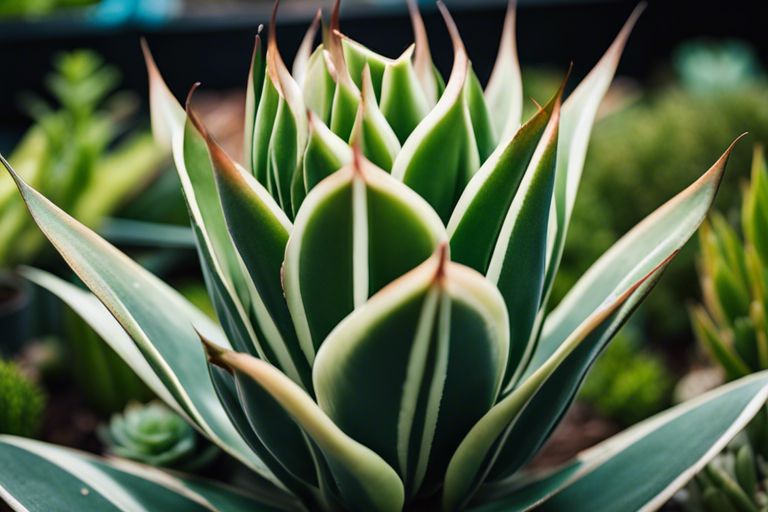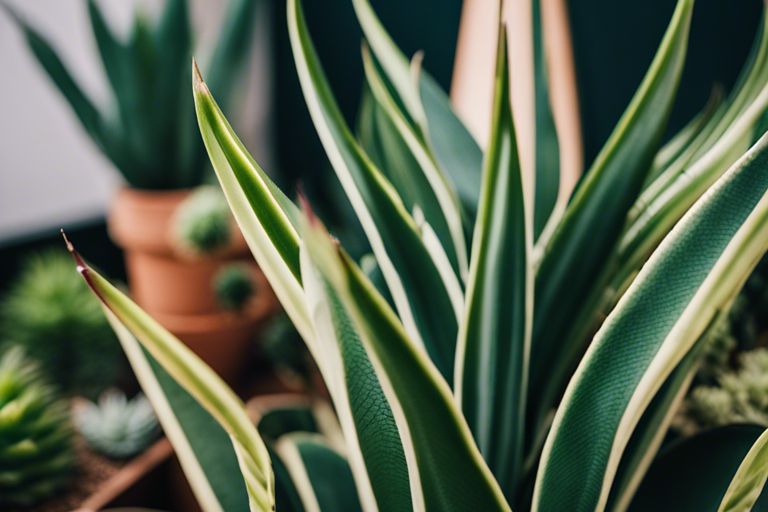It’s time to settle the age-old debate: are snake plants succulents? While they share some characteristics with succulents, these popular houseplants actually belong to a different botanical family. In this post, we’ll investigate into the botanical truth behind snake plants and their classification in the world of plants. For those still unsure, consider checking out this discussion on do snake plants count as a succulent? trying to grow chia …

Key Takeaways:
- Snake plants are not succulents: Despite resembling succulents with their water-storing capabilities, snake plants belong to the Dracaena family, not the succulent family.
- Snake plants have unique characteristics: While they share some characteristics with succulents, such as low water needs and thick leaves, snake plants have distinctive traits that set them apart botanically.
- Succulents are a diverse group: Succulents encompass a wide range of plant species, each with their own unique characteristics, whereas snake plants are a specific type of plant within the Dracaena family.

Understanding Snake Plants
If you’re curious about botanical details, understanding snake plants is necessary to appreciate their unique characteristics. These popular indoor plants belong to the Asparagaceae family, which is different from succulents belonging to the Crassulaceae family. Snake plants, scientifically known as Sansevieria, are native to tropical West Africa and Asia, and they have adapted to survive in various environmental conditions.
Botanical Profile of Snake Plants
Understanding the botanical profile of snake plants involves recognizing their distinct features. These plants have long, upright leaves with striking patterns that vary depending on the variety. They store water in their leaves through a process called CAM photosynthesis, which helps them survive drought conditions. Additionally, snake plants produce oxygen at night, making them ideal bedroom companions for promoting better air quality while you sleep.
Common Varieties and Their Characteristics
Snake plants come in various shapes, sizes, and colors, making them versatile choices for different interior design preferences. The most common varieties include Sansevieria trifasciata (Mother-in-Law’s Tongue), Sansevieria cylindrica (Cylindrical Snake Plant), and Sansevieria robusta (Robust Snake Plant). Mother-in-Law’s Tongue features dark green leaves with light green horizontal stripes, while Cylindrical Snake Plant has cylindrical leaves that grow in a fan shape. Robust Snake Plant stands out with its broad, flat leaves that have mottled patterns on them.
It’s important to note that while snake plants are relatively easy to care for, they can be toxic to pets if ingested. However, their air-purifying qualities and low maintenance requirements make them popular choices for indoor plant enthusiasts. Understanding the common varieties of snake plants allows you to appreciate the diversity within this species and select the perfect one to complement your space.
Exploring Succulents: A Diverse Group of Plants
Defining Traits of Succulents
Grouped under the broad category of succulent plants are a diverse range of species known for their ability to store water in their leaves, stems, or roots. Not all succulents are cacti, but all cacti are considered succulents. One defining trait of succulents is their adaptability to arid environments, where water is scarce. Their unique ability to store water allows them to thrive in conditions that would be challenging for many other plant species.
The Ecological Role and Adaptations of Succulents
Exploring the ecological role and adaptations of succulents unveils a fascinating array of strategies these plants have developed to survive and thrive in harsh environments. The ability to store water in specialized tissues is one of the defining features that enable succulents to withstand long periods of drought. This adaptation not only helps them survive in arid regions but also makes them valuable contributors to ecosystems where water is limited.
The Intersection of Snake Plants and Succulents
After a detailed analysis, it is time to explore the intricate relationship between snake plants and succulents. Despite the ongoing debate, understanding the similarities and differences between these two plant types will shed light on their intricate connection.
Shared Characteristics with Succulent Plants
Shared characteristics between snake plants and succulents offer valuable insights into their botanical nature. One of the most striking similarities is their ability to retain water in their leaves, stems, or roots. This adaptation allows both plants to survive in arid climates with limited water resources. Additionally, both snake plants and succulents have efficient mechanisms to prevent water loss, such as waxy coatings or specialized tissues.
Key Differences from Typical Succulents
Succulents are known for their diverse range of shapes, colors, and sizes, standing out as decorative houseplants. While snake plants share some characteristics with succulents, there are key differences that set them apart. Unlike typical succulents that thrive under full sun exposure, snake plants prefer low light conditions and can tolerate neglect. Another significant difference lies in their growth patterns; succulents often exhibit rapid growth, while snake plants maintain a slow and steady pace of growth.
from the way they absorb nutrients to their growth habits, snake plants exhibit distinct features that differentiate them from typical succulents.
Cultivation and Care
Best Practices for Growing Snake Plants
All snake plants, also known as Sansevieria, are known for their easy care and ability to thrive in low light conditions. The key to successfully growing snake plants is to provide them with well-draining soil and to avoid overwatering. These plants are drought-tolerant, so it is necessary to let the soil dry out between waterings. Snake plants prefer temperatures between 60-85°F and can tolerate a variety of light conditions, from low light to bright, indirect light.
Watering, Soil, and Light Requirements
Regarding caring for snake plants, the mantra to remember is “less is more.” Snake plants are prone to root rot if overwatered, so it is crucial to allow the soil to dry out completely before watering again. A well-draining potting mix, such as a cactus mix, is ideal for snake plants. They can thrive in low light conditions, making them perfect for offices or rooms with little natural light. However, they will grow faster in brighter, indirect light.
With proper care, snake plants can withstand neglect and still thrive. They are excellent air purifiers, removing toxins from the air and improving indoor air quality. Remember to keep them away from pets and small children, as snake plants are toxic if ingested.
Watering
Regarding watering snake plants, less is more. Overwatering is the number one killer of snake plants, so it is vital to let the soil dry out completely between waterings. Stick to a watering schedule of every 2-6 weeks, depending on your home’s temperature and humidity levels. Always err on the side of underwatering rather than overwatering to ensure the health of your snake plant.
Common Misconceptions
For centuries, snake plants have been mistaken for succulents due to their ability to store water in their leaves and survive in arid conditions. However, this misconception has led to a variety of myths surrounding the classification of snake plants. It’s time to set the record straight and debunk these misconceptions once and for all.
Debunking Myths About Snake Plants as Succulents
Misconceptions about snake plants being succulents stem from their similar physical characteristics, such as thick leaves and low watering requirements. However, the truth lies in their botanical classification. While succulents belong to the Crassulaceae family, snake plants are part of the Asparagaceae family. This clear distinction separates them into two distinct plant groups, each with its own unique characteristics and care requirements.
Understanding the Implications of Misidentification
Snake plants being misidentified as succulents can have significant implications, especially when it comes to their care. Although both plant types require minimal watering, their light and temperature needs can differ. Succulents thrive in bright sunlight and warmer temperatures, while snake plants prefer indirect light and can tolerate cooler conditions. Without understanding this distinction, improper care can lead to the decline of these plants.
Common misconceptions about snake plants being succulents can lead to mistreatment and ultimately harm the plants in the long run. By acknowledging the differences in their botanical classification and care requirements, plant enthusiasts can ensure the health and vitality of their snake plants.

The Benefits of Owning Snake Plants
Air-Purifying Qualities and Health Benefits
Unlike many other houseplants, snake plants are not only visually appealing but also offer a host of benefits for your health and well-being. Owning a snake plant can greatly contribute to improving the air quality in your home or office. These plants are known for their ability to purify the air by removing toxins such as formaldehyde, xylene, toluene, and nitrogen oxide. By absorbing these harmful substances and releasing oxygen, snake plants can create a healthier environment for you to breathe in.
In addition to their air-purifying qualities, snake plants have been studied for their potential health benefits. They are believed to have the ability to boost mood, productivity, and concentration. The plant releases oxygen at night, making it an ideal bedroom companion for a better night’s sleep. Furthermore, snake plants are low maintenance, making them an excellent choice for busy individuals looking to incorporate more greenery into their lives.
Aesthetic and Decorative Uses in Home and Office
For those looking to add a touch of green to their living or working space, snake plants are a perfect choice. These plants have a striking appearance with tall, sword-shaped leaves that can complement any decor style. Whether placed in a modern minimalist setting or a cozy traditional room, snake plants add a sophisticated charm to any environment. Their versatility in size and shape makes them suitable for both large living rooms and small office desks.
Benefits: Snake plants not only serve as natural air purifiers and health boosters but also enhance the aesthetic appeal of any space they adorn. With minimal care requirements and maximum visual impact, these plants are a must-have for anyone looking to improve their indoor environment both functionally and aesthetically.
Final Words
Summing up, snake plants are not classified as succulents, despite their similar characteristics such as water retention and low maintenance requirements. While they do share some traits with succulents, snake plants belong to the Asparagaceae family, distinct from the succulent family. Bear in mind, it’s always important to research and understand the botanical classifications of plants to properly care for them and ensure their thriving growth.
